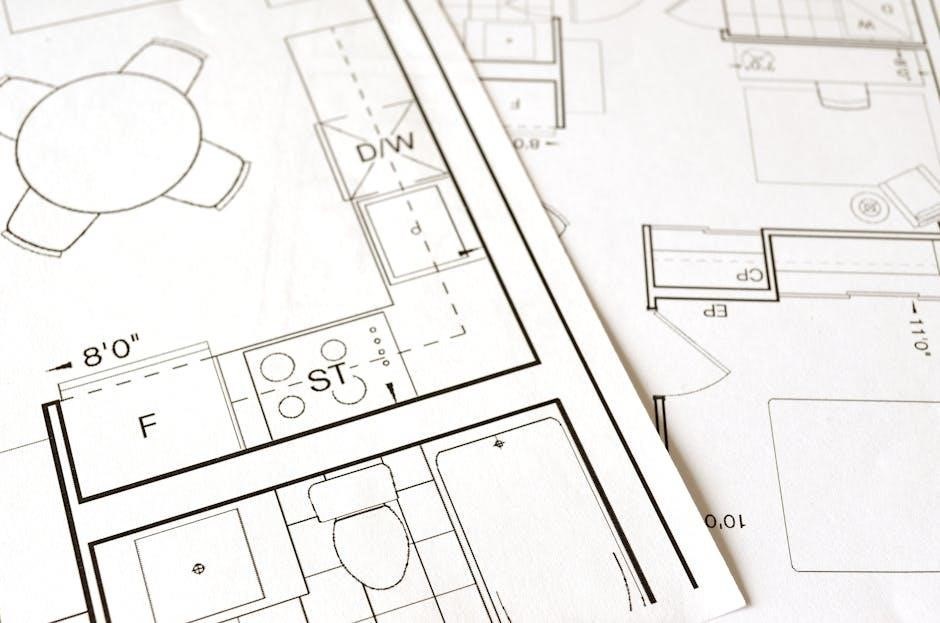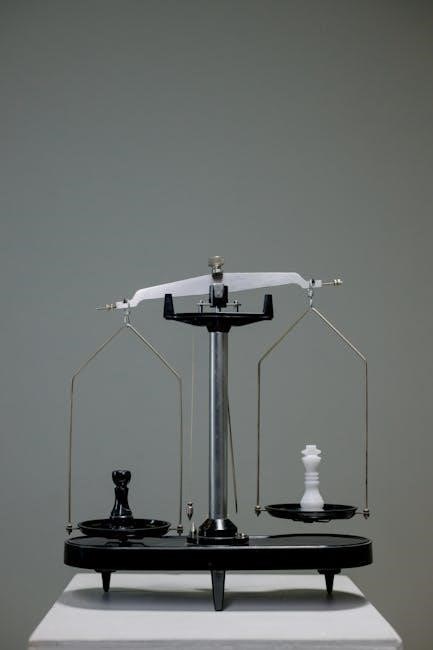The Dyadic Adjustment Scale (DAS) is a 32-item measure assessing relationship quality in cohabiting couples, focusing on consensus, satisfaction, cohesion, and affectional expression, developed by Spanier in 1976.
Overview of the DAS and Its Purpose
The Dyadic Adjustment Scale (DAS) is a widely used self-report measure designed to assess the quality of relationships between cohabiting couples, whether married or unmarried. Its primary purpose is to evaluate key aspects of relationship satisfaction, including communication, conflict resolution, and emotional connection. The scale consists of 32 items divided into four subscales: dyadic consensus, dyadic satisfaction, dyadic cohesion, and affectional expression. These subscales collectively provide a comprehensive understanding of the relationship dynamics. The DAS is utilized both in clinical settings to identify areas of relationship distress and in research to study relationship quality. By measuring agreement, emotional expression, and shared activities, the DAS offers insights into the strengths and challenges of dyadic relationships, making it a valuable tool for both practitioners and researchers.
History and Development of the DAS
The Dyadic Adjustment Scale (DAS) was developed by Graham B. Spanier in 1976 to assess relationship quality in cohabiting couples. Initially designed as a 32-item measure, it was created to evaluate key aspects of dyadic relationships, including communication, conflict resolution, and emotional connection. Over time, the scale has undergone revisions, such as the Revised Dyadic Adjustment Scale (RDAS), which refined its subscales and improved its clinical applicability. The DAS has been widely validated and is now a standard tool in relationship research and clinical practice, providing insights into relationship dynamics and helping identify areas of distress. Its development marked a significant advancement in understanding and measuring relationship satisfaction, making it a cornerstone in marital and family therapy research.

Structure and Subscales of the DAS
The DAS evaluates relationship quality through four subscales—Dyadic Consensus, Dyadic Satisfaction, Dyadic Cohesion, and Affectional Expression—each assessing distinct aspects of couple interactions and relationship dynamics.
Dyadic Consensus
Dyadic Consensus measures the degree of agreement between partners on various aspects of their relationship, including decision-making, values, and conflict resolution. It assesses how often couples agree or disagree on key issues, with responses ranging from “Always Agree” to “Always Disagree.” This subscale is crucial for understanding the alignment of perspectives within the relationship, which can significantly impact overall satisfaction. Higher consensus typically correlates with healthier relationship outcomes, while frequent disagreements may indicate areas needing attention. By evaluating consensus, the DAS provides insights into how well partners navigate shared responsibilities and maintain harmony in their relationship dynamics. This aspect is essential for both research and clinical applications, offering a clear metric to assess and improve relationship quality. The scale’s focus on agreement helps identify strengths and potential challenges in the partnership.

Dyadic Satisfaction
Dyadic Satisfaction evaluates the overall contentment and happiness partners derive from their relationship. It assesses how fulfilled individuals feel regarding their relationship’s stability, emotional connection, and personal needs being met. This subscale captures the degree to which partners feel satisfied with their relationship, reflecting their emotional well-being and commitment. Higher scores indicate greater satisfaction, while lower scores may suggest dissatisfaction or unmet expectations. Dyadic Satisfaction is a critical component of relationship assessment, as it directly relates to the partners’ perceived quality of life within the relationship. By measuring satisfaction, the DAS helps identify areas where couples may benefit from support or therapy to enhance their relationship quality and address potential issues like emotional disconnection or unfulfilled needs.
Dyadic Cohesion
Dyadic Cohesion measures the degree of unity and togetherness experienced by couples in their relationship. It assesses how partners engage in shared activities, communicate effectively, and maintain emotional closeness. This subscale focuses on the quality of interactions, mutual support, and the sense of connection between partners. High cohesion suggests strong relationship bonds and collaborative problem-solving, while low cohesion may indicate isolation or disconnection. Dyadic Cohesion is essential for relationship resilience, as it reflects how well partners work together and maintain a sense of teamwork. By evaluating cohesion, the DAS provides insights into the couple’s ability to function as a united entity, which is vital for navigating challenges and maintaining relationship satisfaction. This aspect is crucial for understanding the foundation of a healthy and enduring partnership.

Affectional Expression
Affectional Expression assesses the degree to which partners express emotional affection and intimacy in their relationship. This subscale evaluates how couples demonstrate love, care, and emotional connection through words and actions. It also explores agreement on emotional matters and the sexual aspects of the relationship. High affectional expression indicates strong emotional intimacy and satisfaction, while low scores may suggest emotional distance or dissatisfaction. The DAS measures this through items that gauge mutual displays of affection, emotional support, and sexual harmony. Affectional Expression is crucial for understanding the emotional quality of the relationship and is often linked to overall relationship satisfaction. By evaluating this dimension, the DAS provides insights into how well partners connect on an emotional and intimate level, which is vital for a fulfilling partnership.

Scoring and Interpretation of the DAS

The DAS is a 32-item measure scored by summing responses across four subscales. Total scores range from 0 to 151, with higher scores indicating better relationship quality. Threshold scores help interpret relationship adjustment, distinguishing between distressed and nondistressed couples.

Scoring Methods and Interpretation Criteria
The DAS is scored by summing responses across its 32 items, yielding a total score ranging from 0 to 151. Higher scores indicate better relationship quality. The scale includes four subscales: Dyadic Consensus, Dyadic Satisfaction, Dyadic Cohesion, and Affectional Expression. Each subscale contributes to the overall score, providing a comprehensive assessment of relationship adjustment. Interpretation criteria often involve comparing total scores to established thresholds, with scores above 97 typically indicating nondistressed relationships and scores below 97 suggesting distress. Clinicians and researchers use these thresholds to evaluate relationship health and identify areas for intervention. The scoring method is straightforward, allowing for easy interpretation without requiring specialized training, making the DAS a practical tool for both clinical and research settings.
Clinical Applications and Threshold Scores
The Dyadic Adjustment Scale (DAS) is widely used in clinical settings to assess relationship distress and guide therapeutic interventions. A total score of 97 or higher typically indicates a nondistressed relationship, while scores below 97 suggest relationship distress. These threshold scores help clinicians identify couples who may benefit from couples therapy or marital counseling. The DAS is also used to monitor progress over time, allowing therapists to evaluate the effectiveness of interventions. In research, the scale is often employed to study relationship dynamics and outcomes. The clear interpretation criteria make it a valuable tool for both practitioners and researchers, aiding in the development of targeted interventions to improve relationship quality and satisfaction;

Revised Dyadic Adjustment Scale (RDAS)

The Revised Dyadic Adjustment Scale (RDAS) is a 14-item self-report questionnaire designed to assess relationship satisfaction and dynamics. It evaluates seven dimensions within three categories: consensus in decision-making and values, satisfaction in relationship stability and conflict regulation, and cohesion through shared activities. Unlike the original DAS, the RDAS is more concise and adaptable, making it suitable for both distressed and nondistressed couples. It is widely used in research and clinical practice to identify relationship distress and monitor therapeutic progress. Specific threshold scores help clinicians determine when interventions may be necessary. The RDAS is versatile, applicable to various types of relationships, and has been validated in studies examining relationship experiences and social support. Its streamlined design enhances efficiency while maintaining comprehensive assessment capabilities.
Key Differences Between DAS and RDAS
The Revised Dyadic Adjustment Scale (RDAS) is a streamlined version of the original DAS, designed to address limitations in the earlier scale. Unlike the DAS, which includes 32 items, the RDAS consists of 14 items, making it more concise and easier to administer. The RDAS also introduces a new structural framework, organizing its dimensions into three overarching categories: consensus in decision-making and values, satisfaction in relationship stability and conflict regulation, and cohesion through shared activities. While the DAS focuses on four subscales, the RDAS simplifies this by reducing redundancy and improving clarity. Additionally, the RDAS provides specific threshold scores for clinical applications, allowing practitioners to identify relationship distress more effectively. These revisions enhance the scale’s practicality and adaptability for both research and clinical settings, addressing some of the original DAS’s limitations in reliability and applicability;
Applications of the RDAS in Research and Practice
The Revised Dyadic Adjustment Scale (RDAS) has found extensive applications in both research and clinical practice due to its reliability and adaptability. In research, the RDAS is frequently used to assess relationship quality, providing insights into dynamics such as communication, intimacy, and conflict resolution. Its concise design makes it ideal for studies requiring multiple measures without participant fatigue. Clinically, the RDAS serves as a valuable tool for identifying distressed relationships, guiding interventions, and monitoring progress over time. Therapists use its subscales to pinpoint specific areas of concern, such as low cohesion or dissatisfaction, enabling targeted interventions. Additionally, the RDAS has been employed in educational settings to study relationship dynamics among diverse populations, aiding in the development of tailored programs aimed at improving relationship satisfaction and resilience.

